Nature Lovers: Management and Workforce Turnover Case Study
VerifiedAdded on 2022/10/14
|8
|2697
|19
Case Study
AI Summary
This case study examines the challenges faced by Nature Lovers, a Vietnamese outdoor sports equipment business, focusing on the critical issue of high employee turnover. The analysis identifies key problems, including founder dependence, lack of employee empowerment, poor interpersonal trust, limited growth opportunities, and ineffective communication. The study links these issues to various theories, such as Herzberg's Two-Factor Theory and Scientific Management theory, and proposes functional human resource activities as solutions. These include systematic selection techniques, team-building activities, and continuing education courses. The recommendations emphasize the importance of hiring competent employees, fostering open communication, and investing in employee training and development. Furthermore, it suggests utilizing digital platforms for efficient hiring processes and conducting team-building events to improve morale and foster a sense of belonging. The case study offers practical strategies for improving employee retention and enhancing overall business performance, particularly for small businesses lacking a dedicated HR department. The study also highlights the importance of leadership in creating a positive work environment to minimize employee turnover.
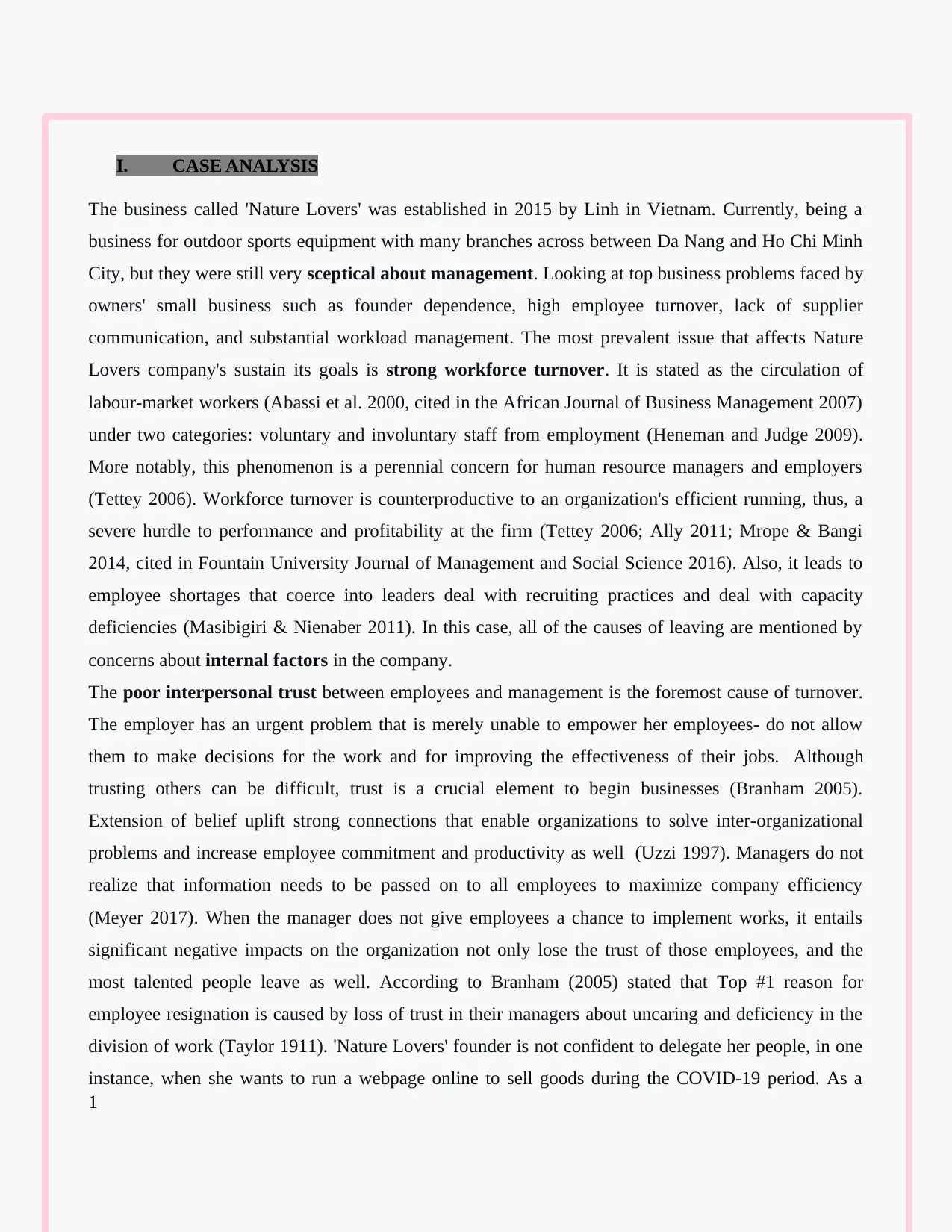
I. CASE ANALYSIS
The business called 'Nature Lovers' was established in 2015 by Linh in Vietnam. Currently, being a
business for outdoor sports equipment with many branches across between Da Nang and Ho Chi Minh
City, but they were still very sceptical about management. Looking at top business problems faced by
owners' small business such as founder dependence, high employee turnover, lack of supplier
communication, and substantial workload management. The most prevalent issue that affects Nature
Lovers company's sustain its goals is strong workforce turnover. It is stated as the circulation of
labour-market workers (Abassi et al. 2000, cited in the African Journal of Business Management 2007)
under two categories: voluntary and involuntary staff from employment (Heneman and Judge 2009).
More notably, this phenomenon is a perennial concern for human resource managers and employers
(Tettey 2006). Workforce turnover is counterproductive to an organization's efficient running, thus, a
severe hurdle to performance and profitability at the firm (Tettey 2006; Ally 2011; Mrope & Bangi
2014, cited in Fountain University Journal of Management and Social Science 2016). Also, it leads to
employee shortages that coerce into leaders deal with recruiting practices and deal with capacity
deficiencies (Masibigiri & Nienaber 2011). In this case, all of the causes of leaving are mentioned by
concerns about internal factors in the company.
The poor interpersonal trust between employees and management is the foremost cause of turnover.
The employer has an urgent problem that is merely unable to empower her employees- do not allow
them to make decisions for the work and for improving the effectiveness of their jobs. Although
trusting others can be difficult, trust is a crucial element to begin businesses (Branham 2005).
Extension of belief uplift strong connections that enable organizations to solve inter-organizational
problems and increase employee commitment and productivity as well (Uzzi 1997). Managers do not
realize that information needs to be passed on to all employees to maximize company efficiency
(Meyer 2017). When the manager does not give employees a chance to implement works, it entails
significant negative impacts on the organization not only lose the trust of those employees, and the
most talented people leave as well. According to Branham (2005) stated that Top #1 reason for
employee resignation is caused by loss of trust in their managers about uncaring and deficiency in the
division of work (Taylor 1911). 'Nature Lovers' founder is not confident to delegate her people, in one
instance, when she wants to run a webpage online to sell goods during the COVID-19 period. As a
1
The business called 'Nature Lovers' was established in 2015 by Linh in Vietnam. Currently, being a
business for outdoor sports equipment with many branches across between Da Nang and Ho Chi Minh
City, but they were still very sceptical about management. Looking at top business problems faced by
owners' small business such as founder dependence, high employee turnover, lack of supplier
communication, and substantial workload management. The most prevalent issue that affects Nature
Lovers company's sustain its goals is strong workforce turnover. It is stated as the circulation of
labour-market workers (Abassi et al. 2000, cited in the African Journal of Business Management 2007)
under two categories: voluntary and involuntary staff from employment (Heneman and Judge 2009).
More notably, this phenomenon is a perennial concern for human resource managers and employers
(Tettey 2006). Workforce turnover is counterproductive to an organization's efficient running, thus, a
severe hurdle to performance and profitability at the firm (Tettey 2006; Ally 2011; Mrope & Bangi
2014, cited in Fountain University Journal of Management and Social Science 2016). Also, it leads to
employee shortages that coerce into leaders deal with recruiting practices and deal with capacity
deficiencies (Masibigiri & Nienaber 2011). In this case, all of the causes of leaving are mentioned by
concerns about internal factors in the company.
The poor interpersonal trust between employees and management is the foremost cause of turnover.
The employer has an urgent problem that is merely unable to empower her employees- do not allow
them to make decisions for the work and for improving the effectiveness of their jobs. Although
trusting others can be difficult, trust is a crucial element to begin businesses (Branham 2005).
Extension of belief uplift strong connections that enable organizations to solve inter-organizational
problems and increase employee commitment and productivity as well (Uzzi 1997). Managers do not
realize that information needs to be passed on to all employees to maximize company efficiency
(Meyer 2017). When the manager does not give employees a chance to implement works, it entails
significant negative impacts on the organization not only lose the trust of those employees, and the
most talented people leave as well. According to Branham (2005) stated that Top #1 reason for
employee resignation is caused by loss of trust in their managers about uncaring and deficiency in the
division of work (Taylor 1911). 'Nature Lovers' founder is not confident to delegate her people, in one
instance, when she wants to run a webpage online to sell goods during the COVID-19 period. As a
1
Paraphrase This Document
Need a fresh take? Get an instant paraphrase of this document with our AI Paraphraser
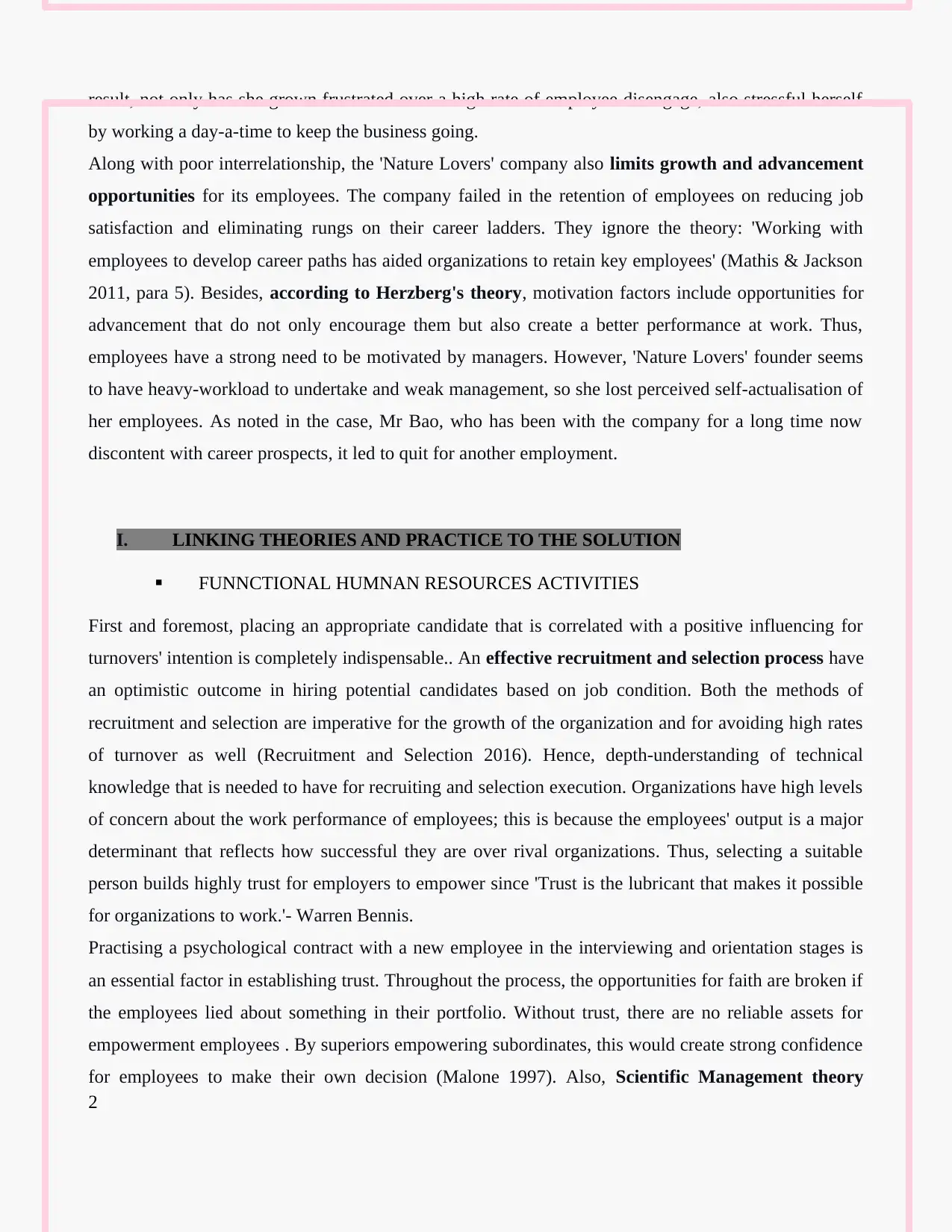
result, not only has she grown frustrated over a high rate of employee disengage, also stressful herself
by working a day-a-time to keep the business going.
Along with poor interrelationship, the 'Nature Lovers' company also limits growth and advancement
opportunities for its employees. The company failed in the retention of employees on reducing job
satisfaction and eliminating rungs on their career ladders. They ignore the theory: 'Working with
employees to develop career paths has aided organizations to retain key employees' (Mathis & Jackson
2011, para 5). Besides, according to Herzberg's theory, motivation factors include opportunities for
advancement that do not only encourage them but also create a better performance at work. Thus,
employees have a strong need to be motivated by managers. However, 'Nature Lovers' founder seems
to have heavy-workload to undertake and weak management, so she lost perceived self-actualisation of
her employees. As noted in the case, Mr Bao, who has been with the company for a long time now
discontent with career prospects, it led to quit for another employment.
I. LINKING THEORIES AND PRACTICE TO THE SOLUTION
FUNNCTIONAL HUMNAN RESOURCES ACTIVITIES
First and foremost, placing an appropriate candidate that is correlated with a positive influencing for
turnovers' intention is completely indispensable.. An effective recruitment and selection process have
an optimistic outcome in hiring potential candidates based on job condition. Both the methods of
recruitment and selection are imperative for the growth of the organization and for avoiding high rates
of turnover as well (Recruitment and Selection 2016). Hence, depth-understanding of technical
knowledge that is needed to have for recruiting and selection execution. Organizations have high levels
of concern about the work performance of employees; this is because the employees' output is a major
determinant that reflects how successful they are over rival organizations. Thus, selecting a suitable
person builds highly trust for employers to empower since 'Trust is the lubricant that makes it possible
for organizations to work.'- Warren Bennis.
Practising a psychological contract with a new employee in the interviewing and orientation stages is
an essential factor in establishing trust. Throughout the process, the opportunities for faith are broken if
the employees lied about something in their portfolio. Without trust, there are no reliable assets for
empowerment employees . By superiors empowering subordinates, this would create strong confidence
for employees to make their own decision (Malone 1997). Also, Scientific Management theory
2
by working a day-a-time to keep the business going.
Along with poor interrelationship, the 'Nature Lovers' company also limits growth and advancement
opportunities for its employees. The company failed in the retention of employees on reducing job
satisfaction and eliminating rungs on their career ladders. They ignore the theory: 'Working with
employees to develop career paths has aided organizations to retain key employees' (Mathis & Jackson
2011, para 5). Besides, according to Herzberg's theory, motivation factors include opportunities for
advancement that do not only encourage them but also create a better performance at work. Thus,
employees have a strong need to be motivated by managers. However, 'Nature Lovers' founder seems
to have heavy-workload to undertake and weak management, so she lost perceived self-actualisation of
her employees. As noted in the case, Mr Bao, who has been with the company for a long time now
discontent with career prospects, it led to quit for another employment.
I. LINKING THEORIES AND PRACTICE TO THE SOLUTION
FUNNCTIONAL HUMNAN RESOURCES ACTIVITIES
First and foremost, placing an appropriate candidate that is correlated with a positive influencing for
turnovers' intention is completely indispensable.. An effective recruitment and selection process have
an optimistic outcome in hiring potential candidates based on job condition. Both the methods of
recruitment and selection are imperative for the growth of the organization and for avoiding high rates
of turnover as well (Recruitment and Selection 2016). Hence, depth-understanding of technical
knowledge that is needed to have for recruiting and selection execution. Organizations have high levels
of concern about the work performance of employees; this is because the employees' output is a major
determinant that reflects how successful they are over rival organizations. Thus, selecting a suitable
person builds highly trust for employers to empower since 'Trust is the lubricant that makes it possible
for organizations to work.'- Warren Bennis.
Practising a psychological contract with a new employee in the interviewing and orientation stages is
an essential factor in establishing trust. Throughout the process, the opportunities for faith are broken if
the employees lied about something in their portfolio. Without trust, there are no reliable assets for
empowerment employees . By superiors empowering subordinates, this would create strong confidence
for employees to make their own decision (Malone 1997). Also, Scientific Management theory
2
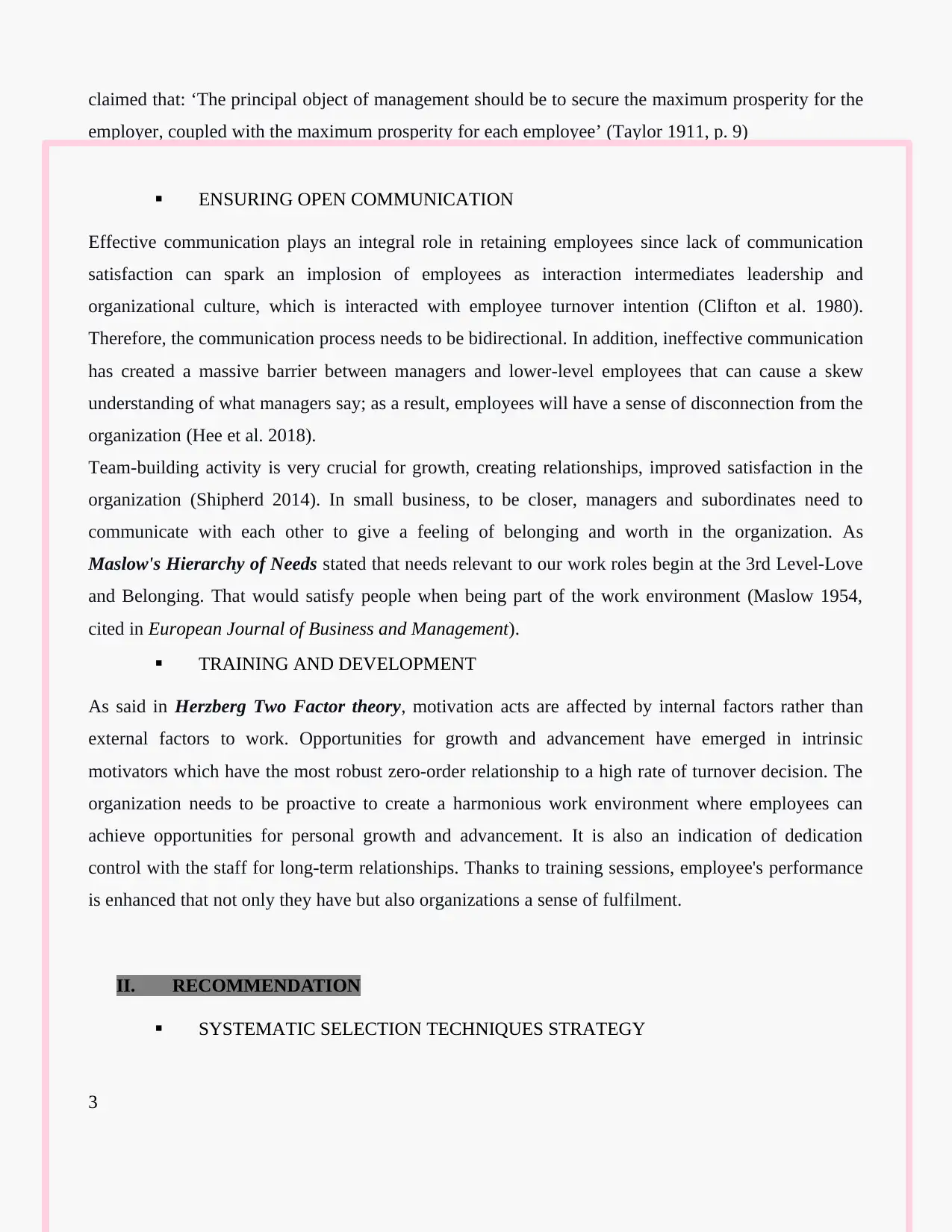
claimed that: ‘The principal object of management should be to secure the maximum prosperity for the
employer, coupled with the maximum prosperity for each employee’ (Taylor 1911, p. 9)
ENSURING OPEN COMMUNICATION
Effective communication plays an integral role in retaining employees since lack of communication
satisfaction can spark an implosion of employees as interaction intermediates leadership and
organizational culture, which is interacted with employee turnover intention (Clifton et al. 1980).
Therefore, the communication process needs to be bidirectional. In addition, ineffective communication
has created a massive barrier between managers and lower-level employees that can cause a skew
understanding of what managers say; as a result, employees will have a sense of disconnection from the
organization (Hee et al. 2018).
Team-building activity is very crucial for growth, creating relationships, improved satisfaction in the
organization (Shipherd 2014). In small business, to be closer, managers and subordinates need to
communicate with each other to give a feeling of belonging and worth in the organization. As
Maslow's Hierarchy of Needs stated that needs relevant to our work roles begin at the 3rd Level-Love
and Belonging. That would satisfy people when being part of the work environment (Maslow 1954,
cited in European Journal of Business and Management).
TRAINING AND DEVELOPMENT
As said in Herzberg Two Factor theory, motivation acts are affected by internal factors rather than
external factors to work. Opportunities for growth and advancement have emerged in intrinsic
motivators which have the most robust zero-order relationship to a high rate of turnover decision. The
organization needs to be proactive to create a harmonious work environment where employees can
achieve opportunities for personal growth and advancement. It is also an indication of dedication
control with the staff for long-term relationships. Thanks to training sessions, employee's performance
is enhanced that not only they have but also organizations a sense of fulfilment.
II. RECOMMENDATION
SYSTEMATIC SELECTION TECHNIQUES STRATEGY
3
employer, coupled with the maximum prosperity for each employee’ (Taylor 1911, p. 9)
ENSURING OPEN COMMUNICATION
Effective communication plays an integral role in retaining employees since lack of communication
satisfaction can spark an implosion of employees as interaction intermediates leadership and
organizational culture, which is interacted with employee turnover intention (Clifton et al. 1980).
Therefore, the communication process needs to be bidirectional. In addition, ineffective communication
has created a massive barrier between managers and lower-level employees that can cause a skew
understanding of what managers say; as a result, employees will have a sense of disconnection from the
organization (Hee et al. 2018).
Team-building activity is very crucial for growth, creating relationships, improved satisfaction in the
organization (Shipherd 2014). In small business, to be closer, managers and subordinates need to
communicate with each other to give a feeling of belonging and worth in the organization. As
Maslow's Hierarchy of Needs stated that needs relevant to our work roles begin at the 3rd Level-Love
and Belonging. That would satisfy people when being part of the work environment (Maslow 1954,
cited in European Journal of Business and Management).
TRAINING AND DEVELOPMENT
As said in Herzberg Two Factor theory, motivation acts are affected by internal factors rather than
external factors to work. Opportunities for growth and advancement have emerged in intrinsic
motivators which have the most robust zero-order relationship to a high rate of turnover decision. The
organization needs to be proactive to create a harmonious work environment where employees can
achieve opportunities for personal growth and advancement. It is also an indication of dedication
control with the staff for long-term relationships. Thanks to training sessions, employee's performance
is enhanced that not only they have but also organizations a sense of fulfilment.
II. RECOMMENDATION
SYSTEMATIC SELECTION TECHNIQUES STRATEGY
3
⊘ This is a preview!⊘
Do you want full access?
Subscribe today to unlock all pages.

Trusted by 1+ million students worldwide
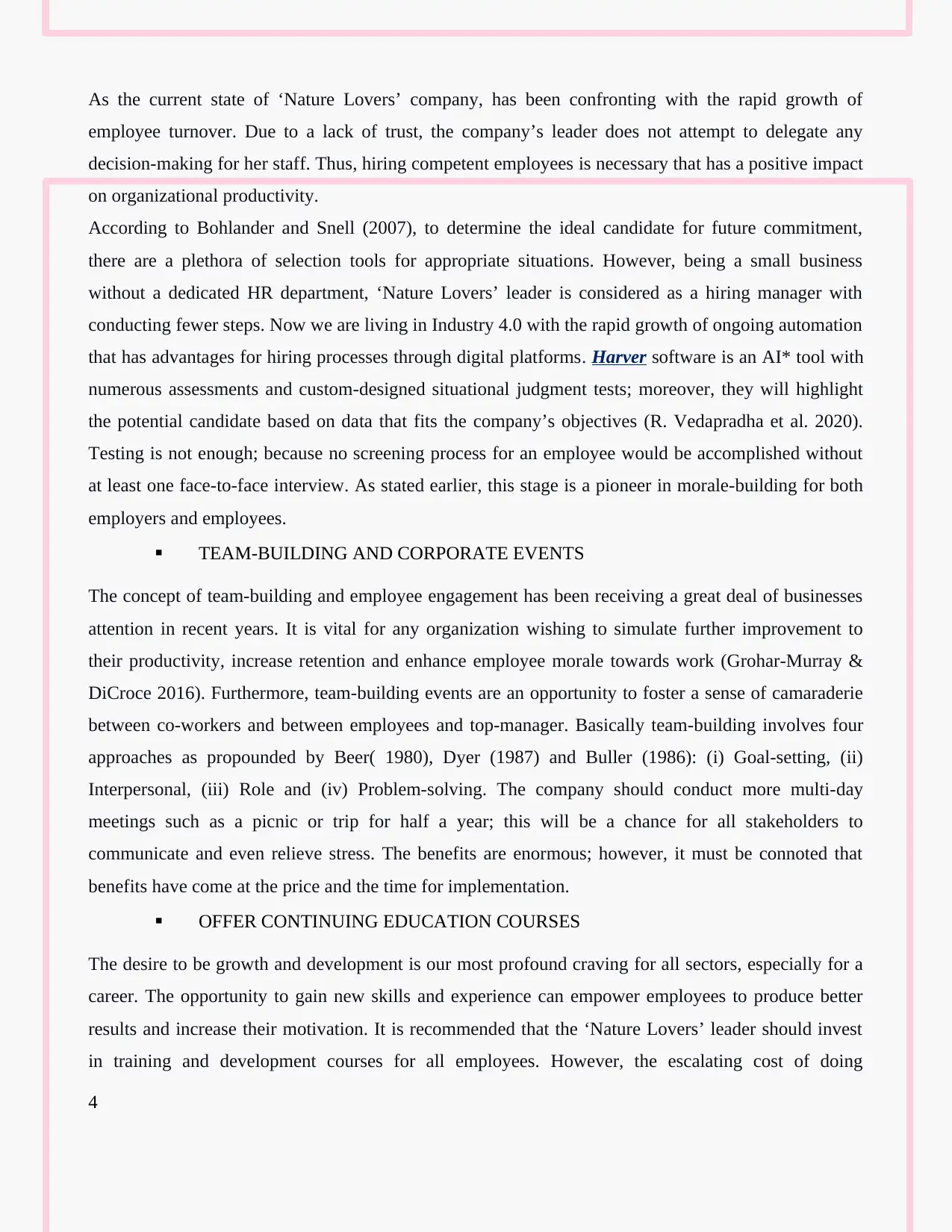
As the current state of ‘Nature Lovers’ company, has been confronting with the rapid growth of
employee turnover. Due to a lack of trust, the company’s leader does not attempt to delegate any
decision-making for her staff. Thus, hiring competent employees is necessary that has a positive impact
on organizational productivity.
According to Bohlander and Snell (2007), to determine the ideal candidate for future commitment,
there are a plethora of selection tools for appropriate situations. However, being a small business
without a dedicated HR department, ‘Nature Lovers’ leader is considered as a hiring manager with
conducting fewer steps. Now we are living in Industry 4.0 with the rapid growth of ongoing automation
that has advantages for hiring processes through digital platforms. Harver software is an AI* tool with
numerous assessments and custom-designed situational judgment tests; moreover, they will highlight
the potential candidate based on data that fits the company’s objectives (R. Vedapradha et al. 2020).
Testing is not enough; because no screening process for an employee would be accomplished without
at least one face-to-face interview. As stated earlier, this stage is a pioneer in morale-building for both
employers and employees.
TEAM-BUILDING AND CORPORATE EVENTS
The concept of team-building and employee engagement has been receiving a great deal of businesses
attention in recent years. It is vital for any organization wishing to simulate further improvement to
their productivity, increase retention and enhance employee morale towards work (Grohar-Murray &
DiCroce 2016). Furthermore, team-building events are an opportunity to foster a sense of camaraderie
between co-workers and between employees and top-manager. Basically team-building involves four
approaches as propounded by Beer( 1980), Dyer (1987) and Buller (1986): (i) Goal-setting, (ii)
Interpersonal, (iii) Role and (iv) Problem-solving. The company should conduct more multi-day
meetings such as a picnic or trip for half a year; this will be a chance for all stakeholders to
communicate and even relieve stress. The benefits are enormous; however, it must be connoted that
benefits have come at the price and the time for implementation.
OFFER CONTINUING EDUCATION COURSES
The desire to be growth and development is our most profound craving for all sectors, especially for a
career. The opportunity to gain new skills and experience can empower employees to produce better
results and increase their motivation. It is recommended that the ‘Nature Lovers’ leader should invest
in training and development courses for all employees. However, the escalating cost of doing
4
employee turnover. Due to a lack of trust, the company’s leader does not attempt to delegate any
decision-making for her staff. Thus, hiring competent employees is necessary that has a positive impact
on organizational productivity.
According to Bohlander and Snell (2007), to determine the ideal candidate for future commitment,
there are a plethora of selection tools for appropriate situations. However, being a small business
without a dedicated HR department, ‘Nature Lovers’ leader is considered as a hiring manager with
conducting fewer steps. Now we are living in Industry 4.0 with the rapid growth of ongoing automation
that has advantages for hiring processes through digital platforms. Harver software is an AI* tool with
numerous assessments and custom-designed situational judgment tests; moreover, they will highlight
the potential candidate based on data that fits the company’s objectives (R. Vedapradha et al. 2020).
Testing is not enough; because no screening process for an employee would be accomplished without
at least one face-to-face interview. As stated earlier, this stage is a pioneer in morale-building for both
employers and employees.
TEAM-BUILDING AND CORPORATE EVENTS
The concept of team-building and employee engagement has been receiving a great deal of businesses
attention in recent years. It is vital for any organization wishing to simulate further improvement to
their productivity, increase retention and enhance employee morale towards work (Grohar-Murray &
DiCroce 2016). Furthermore, team-building events are an opportunity to foster a sense of camaraderie
between co-workers and between employees and top-manager. Basically team-building involves four
approaches as propounded by Beer( 1980), Dyer (1987) and Buller (1986): (i) Goal-setting, (ii)
Interpersonal, (iii) Role and (iv) Problem-solving. The company should conduct more multi-day
meetings such as a picnic or trip for half a year; this will be a chance for all stakeholders to
communicate and even relieve stress. The benefits are enormous; however, it must be connoted that
benefits have come at the price and the time for implementation.
OFFER CONTINUING EDUCATION COURSES
The desire to be growth and development is our most profound craving for all sectors, especially for a
career. The opportunity to gain new skills and experience can empower employees to produce better
results and increase their motivation. It is recommended that the ‘Nature Lovers’ leader should invest
in training and development courses for all employees. However, the escalating cost of doing
4
Paraphrase This Document
Need a fresh take? Get an instant paraphrase of this document with our AI Paraphraser
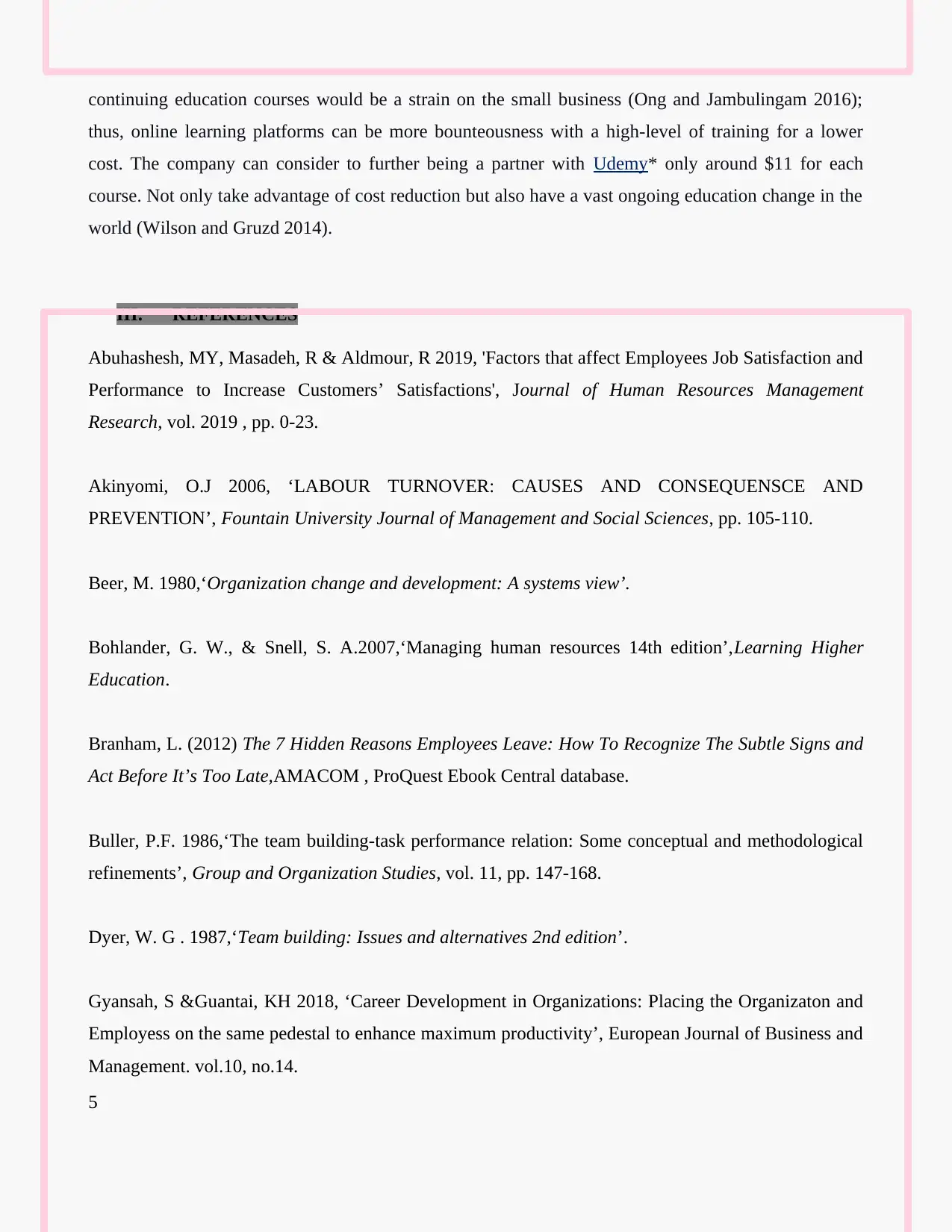
continuing education courses would be a strain on the small business (Ong and Jambulingam 2016);
thus, online learning platforms can be more bounteousness with a high-level of training for a lower
cost. The company can consider to further being a partner with Udemy* only around $11 for each
course. Not only take advantage of cost reduction but also have a vast ongoing education change in the
world (Wilson and Gruzd 2014).
III. REFERENCES
Abuhashesh, MY, Masadeh, R & Aldmour, R 2019, 'Factors that affect Employees Job Satisfaction and
Performance to Increase Customers’ Satisfactions', Journal of Human Resources Management
Research, vol. 2019 , pp. 0-23.
Akinyomi, O.J 2006, ‘LABOUR TURNOVER: CAUSES AND CONSEQUENSCE AND
PREVENTION’, Fountain University Journal of Management and Social Sciences, pp. 105-110.
Beer, M. 1980,‘Organization change and development: A systems view’.
Bohlander, G. W., & Snell, S. A.2007,‘Managing human resources 14th edition’,Learning Higher
Education.
Branham, L. (2012) The 7 Hidden Reasons Employees Leave: How To Recognize The Subtle Signs and
Act Before It’s Too Late,AMACOM , ProQuest Ebook Central database.
Buller, P.F. 1986,‘The team building-task performance relation: Some conceptual and methodological
refinements’, Group and Organization Studies, vol. 11, pp. 147-168.
Dyer, W. G . 1987,‘Team building: Issues and alternatives 2nd edition’.
Gyansah, S &Guantai, KH 2018, ‘Career Development in Organizations: Placing the Organizaton and
Employess on the same pedestal to enhance maximum productivity’, European Journal of Business and
Management. vol.10, no.14.
5
thus, online learning platforms can be more bounteousness with a high-level of training for a lower
cost. The company can consider to further being a partner with Udemy* only around $11 for each
course. Not only take advantage of cost reduction but also have a vast ongoing education change in the
world (Wilson and Gruzd 2014).
III. REFERENCES
Abuhashesh, MY, Masadeh, R & Aldmour, R 2019, 'Factors that affect Employees Job Satisfaction and
Performance to Increase Customers’ Satisfactions', Journal of Human Resources Management
Research, vol. 2019 , pp. 0-23.
Akinyomi, O.J 2006, ‘LABOUR TURNOVER: CAUSES AND CONSEQUENSCE AND
PREVENTION’, Fountain University Journal of Management and Social Sciences, pp. 105-110.
Beer, M. 1980,‘Organization change and development: A systems view’.
Bohlander, G. W., & Snell, S. A.2007,‘Managing human resources 14th edition’,Learning Higher
Education.
Branham, L. (2012) The 7 Hidden Reasons Employees Leave: How To Recognize The Subtle Signs and
Act Before It’s Too Late,AMACOM , ProQuest Ebook Central database.
Buller, P.F. 1986,‘The team building-task performance relation: Some conceptual and methodological
refinements’, Group and Organization Studies, vol. 11, pp. 147-168.
Dyer, W. G . 1987,‘Team building: Issues and alternatives 2nd edition’.
Gyansah, S &Guantai, KH 2018, ‘Career Development in Organizations: Placing the Organizaton and
Employess on the same pedestal to enhance maximum productivity’, European Journal of Business and
Management. vol.10, no.14.
5
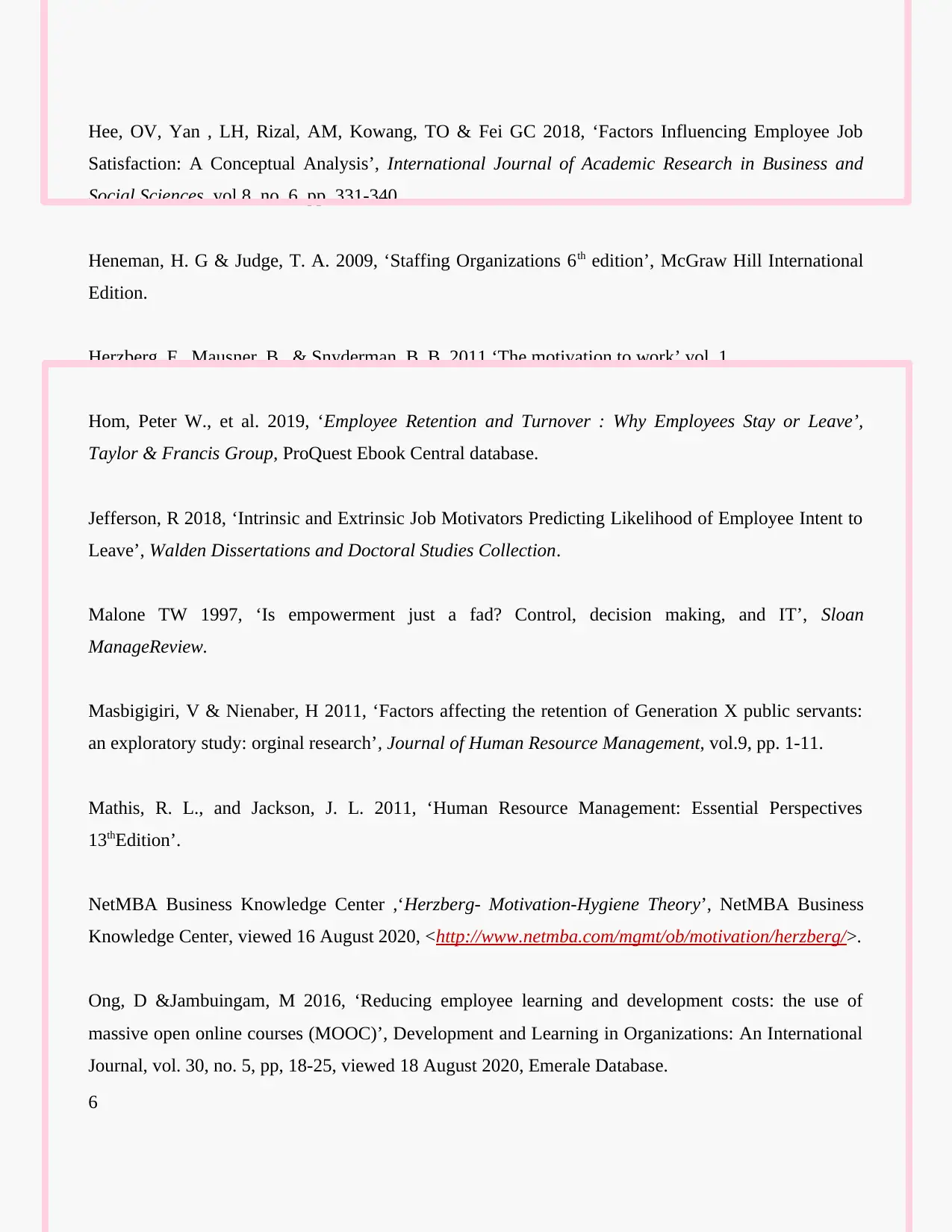
Hee, OV, Yan , LH, Rizal, AM, Kowang, TO & Fei GC 2018, ‘Factors Influencing Employee Job
Satisfaction: A Conceptual Analysis’, International Journal of Academic Research in Business and
Social Sciences, vol.8, no. 6, pp. 331-340.
Heneman, H. G & Judge, T. A. 2009, ‘Staffing Organizations 6th edition’, McGraw Hill International
Edition.
Herzberg, F., Mausner, B., & Snyderman, B. B. 2011,‘The motivation to work’,vol. 1.
Hom, Peter W., et al. 2019, ‘Employee Retention and Turnover : Why Employees Stay or Leave’,
Taylor & Francis Group, ProQuest Ebook Central database.
Jefferson, R 2018, ‘Intrinsic and Extrinsic Job Motivators Predicting Likelihood of Employee Intent to
Leave’, Walden Dissertations and Doctoral Studies Collection.
Malone TW 1997, ‘Is empowerment just a fad? Control, decision making, and IT’, Sloan
ManageReview.
Masbigigiri, V & Nienaber, H 2011, ‘Factors affecting the retention of Generation X public servants:
an exploratory study: orginal research’, Journal of Human Resource Management, vol.9, pp. 1-11.
Mathis, R. L., and Jackson, J. L. 2011, ‘Human Resource Management: Essential Perspectives
13thEdition’.
NetMBA Business Knowledge Center ,‘Herzberg- Motivation-Hygiene Theory’, NetMBA Business
Knowledge Center, viewed 16 August 2020, <http://www.netmba.com/mgmt/ob/motivation/herzberg/>.
Ong, D &Jambuingam, M 2016, ‘Reducing employee learning and development costs: the use of
massive open online courses (MOOC)’, Development and Learning in Organizations: An International
Journal, vol. 30, no. 5, pp, 18-25, viewed 18 August 2020, Emerale Database.
6
Satisfaction: A Conceptual Analysis’, International Journal of Academic Research in Business and
Social Sciences, vol.8, no. 6, pp. 331-340.
Heneman, H. G & Judge, T. A. 2009, ‘Staffing Organizations 6th edition’, McGraw Hill International
Edition.
Herzberg, F., Mausner, B., & Snyderman, B. B. 2011,‘The motivation to work’,vol. 1.
Hom, Peter W., et al. 2019, ‘Employee Retention and Turnover : Why Employees Stay or Leave’,
Taylor & Francis Group, ProQuest Ebook Central database.
Jefferson, R 2018, ‘Intrinsic and Extrinsic Job Motivators Predicting Likelihood of Employee Intent to
Leave’, Walden Dissertations and Doctoral Studies Collection.
Malone TW 1997, ‘Is empowerment just a fad? Control, decision making, and IT’, Sloan
ManageReview.
Masbigigiri, V & Nienaber, H 2011, ‘Factors affecting the retention of Generation X public servants:
an exploratory study: orginal research’, Journal of Human Resource Management, vol.9, pp. 1-11.
Mathis, R. L., and Jackson, J. L. 2011, ‘Human Resource Management: Essential Perspectives
13thEdition’.
NetMBA Business Knowledge Center ,‘Herzberg- Motivation-Hygiene Theory’, NetMBA Business
Knowledge Center, viewed 16 August 2020, <http://www.netmba.com/mgmt/ob/motivation/herzberg/>.
Ong, D &Jambuingam, M 2016, ‘Reducing employee learning and development costs: the use of
massive open online courses (MOOC)’, Development and Learning in Organizations: An International
Journal, vol. 30, no. 5, pp, 18-25, viewed 18 August 2020, Emerale Database.
6
⊘ This is a preview!⊘
Do you want full access?
Subscribe today to unlock all pages.

Trusted by 1+ million students worldwide
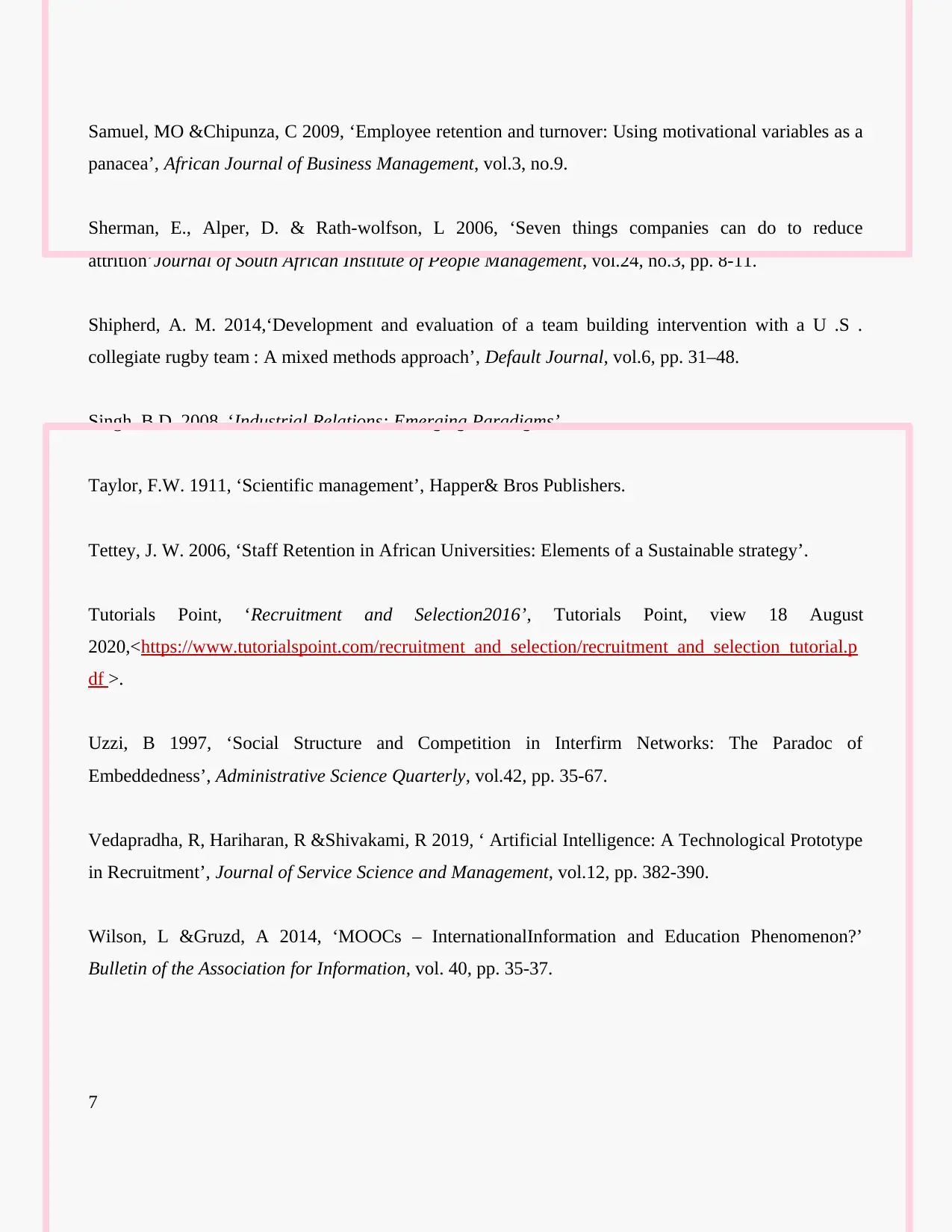
Samuel, MO &Chipunza, C 2009, ‘Employee retention and turnover: Using motivational variables as a
panacea’, African Journal of Business Management, vol.3, no.9.
Sherman, E., Alper, D. & Rath-wolfson, L 2006, ‘Seven things companies can do to reduce
attrition’Journal of South African Institute of People Management, vol.24, no.3, pp. 8-11.
Shipherd, A. M. 2014,‘Development and evaluation of a team building intervention with a U .S .
collegiate rugby team : A mixed methods approach’, Default Journal, vol.6, pp. 31–48.
Singh, B.D. 2008, ‘Industrial Relations: Emerging Paradigms’.
Taylor, F.W. 1911, ‘Scientific management’, Happer& Bros Publishers.
Tettey, J. W. 2006, ‘Staff Retention in African Universities: Elements of a Sustainable strategy’.
Tutorials Point, ‘Recruitment and Selection2016’, Tutorials Point, view 18 August
2020,<https://www.tutorialspoint.com/recruitment_and_selection/recruitment_and_selection_tutorial.p
df >.
Uzzi, B 1997, ‘Social Structure and Competition in Interfirm Networks: The Paradoc of
Embeddedness’, Administrative Science Quarterly, vol.42, pp. 35-67.
Vedapradha, R, Hariharan, R &Shivakami, R 2019, ‘ Artificial Intelligence: A Technological Prototype
in Recruitment’, Journal of Service Science and Management, vol.12, pp. 382-390.
Wilson, L &Gruzd, A 2014, ‘MOOCs – InternationalInformation and Education Phenomenon?’
Bulletin of the Association for Information, vol. 40, pp. 35-37.
7
panacea’, African Journal of Business Management, vol.3, no.9.
Sherman, E., Alper, D. & Rath-wolfson, L 2006, ‘Seven things companies can do to reduce
attrition’Journal of South African Institute of People Management, vol.24, no.3, pp. 8-11.
Shipherd, A. M. 2014,‘Development and evaluation of a team building intervention with a U .S .
collegiate rugby team : A mixed methods approach’, Default Journal, vol.6, pp. 31–48.
Singh, B.D. 2008, ‘Industrial Relations: Emerging Paradigms’.
Taylor, F.W. 1911, ‘Scientific management’, Happer& Bros Publishers.
Tettey, J. W. 2006, ‘Staff Retention in African Universities: Elements of a Sustainable strategy’.
Tutorials Point, ‘Recruitment and Selection2016’, Tutorials Point, view 18 August
2020,<https://www.tutorialspoint.com/recruitment_and_selection/recruitment_and_selection_tutorial.p
df >.
Uzzi, B 1997, ‘Social Structure and Competition in Interfirm Networks: The Paradoc of
Embeddedness’, Administrative Science Quarterly, vol.42, pp. 35-67.
Vedapradha, R, Hariharan, R &Shivakami, R 2019, ‘ Artificial Intelligence: A Technological Prototype
in Recruitment’, Journal of Service Science and Management, vol.12, pp. 382-390.
Wilson, L &Gruzd, A 2014, ‘MOOCs – InternationalInformation and Education Phenomenon?’
Bulletin of the Association for Information, vol. 40, pp. 35-37.
7
Paraphrase This Document
Need a fresh take? Get an instant paraphrase of this document with our AI Paraphraser

8
1 out of 8
Related Documents
Your All-in-One AI-Powered Toolkit for Academic Success.
+13062052269
info@desklib.com
Available 24*7 on WhatsApp / Email
![[object Object]](/_next/static/media/star-bottom.7253800d.svg)
Unlock your academic potential
Copyright © 2020–2025 A2Z Services. All Rights Reserved. Developed and managed by ZUCOL.





